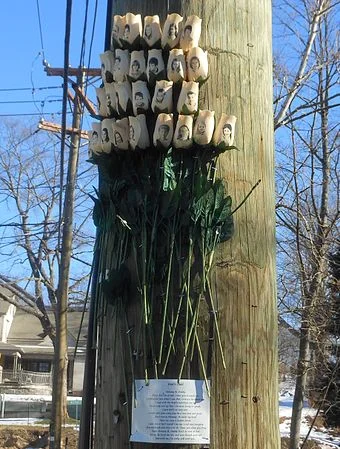Don Pesci: Sandy Hook massacre revisited and reanalyzed
Roses featuring images of victims of the Sandy Hook Elementary School massacre.
VERNON, Conn.
Documents just released years after a shooter murdered 20 students, 6 teachers and his mother, and then killed himself, at Sandy Hook Elementary School, in Newtown, Conn., on Dec. 14, 2012, have been made available to Connecticut politicians and the general public in answer to a legal action brought by a persistent Hartford Courant.
The documents had been carefully tucked away for five years and clearly point to the social and mental deficiencies of the shooter.
All reports should have been released soon after the shooter’s suicide, because none of the information contained therein could have prejudiced any legal action. It is impossible to put a dead mass-shooter on trial for murder. In the absence of the necessary data unearthed above, a public trial of sorts, some of it sprinkled with absurd speculations, was conducted entirely in the mass media, and eventually one of the weapons used in the mass slaughter, an AR15 semi-automatic rifle, was pronounced guilty and banned in Connecticut.
Arguing that “something must be done” to prevent such slaughters in the future, decision makers in Connecticut banned some weapons, aspersed the state with their emotional solidarity with the victims, passed hastily constructed anti-gun legislation and congratulated themselves on their moral acuity.
The released documents, the Los Angeles Times noted, “which had been kept from the public until now, were part of the mass of writings, records and computer files seized by detectives from the Lanza's home after the killings. The Courant mounted a five-year quest to obtain the unreleased documents, eventually winning an appeal before the Connecticut Supreme Court.”
Even though we know that the Devil resides in details, not everyone was thrilled with the release of the documentation. The story, one letter writer noted, could not be justified because it “exalted the killer” and the rest of the country, the writer mused, “are looking for articles that uplift, as well as inform and educate.” Another writer slammed the paper for “choosing the sensational low road to infamy by publishing on page one… the Newtown killer’s writings, thoughts and other tripe… The killer has no place in our collective memory – ever.” Yet another writer winced, “We do not need to know.”
In an editor’s note, The Hartford Courant pointed out, “Understanding what a mass killer was thinking not only paints a clearer picture of the individual, it helps us identify and understand red flags that could be part of a prevention formula for future mass shootings.”
Several weeks after the shooting, Connecticut Commentary noted, “Everyone in Connecticut whose hearts have been bruised by the loss of life in Sandy Hook -- that is, everyone in Connecticut – is praying for solutions that solve the problems of people who have been bludgeoned by reality. A political milking of the crisis helps only the milkers.”
Those solutions were not forthcoming for a number of reasons: The Devil managed to hold the details close to his chest. Some politicians were, it turned out, very much interested in milking the Sandy Hook cow in such a way as to clamp restrictions on firearms, thus benefiting their future political prospects; and Connecticut’s media, though it tried mightily, had failed to wrest from the Devil the details upon which a real solution to a real problem might have been proposed. The so called “red flags” flourished by the Courant in its own attempt to uncover pertinent details were fluttering six years ago, when the psychotic shooter murdered the children and staff of Sandy Hook Elementary School.
We know now – and knew then – the red flags that signaled mental distress.
PsychDrugShooters.com provides a detailed list of school shootings connected to shooters who have taken drugs. Their brief report on the Sandy Hook shooter notes that “While Lanza’s toxicology report showed no traces of anti-psychotic medications, sources say he was prescribed the antidepressant Celexa by the Yale Child Study Center in his early teens. Lanza also took Lexapro for a short time as a teen, but stopped after his mother reported symptoms such as dizziness, sweating, slurred speech and the inability to open his cereal box.”
A piece in the New Yorker, which draws on an interview with the father of the shooter, asserts that the shooter took no further psychotropic drugs following his reaction to Lexapro. Indeed doctors and nurses who treated the shooter speculate that the shooter's psychosis worsened because of his refusal to take therapeutic drugs.
Clearly, the shooter was anti-social and mentally disturbed. The father believes that his son’s Asperger diagnosis, though it may have been correct, masked a more dangerous psychosis. Neither the father nor the mother of the shooter, who had retreated into an impenetrable shell, expected violence from their son.
They were wrong. But the data suggest an that people who thought that the myriad of gun restrictions imposed after the murders could prevent further instances of this kind were also wrong.
Don Pesci is a columnist based in Vernon, Conn.

